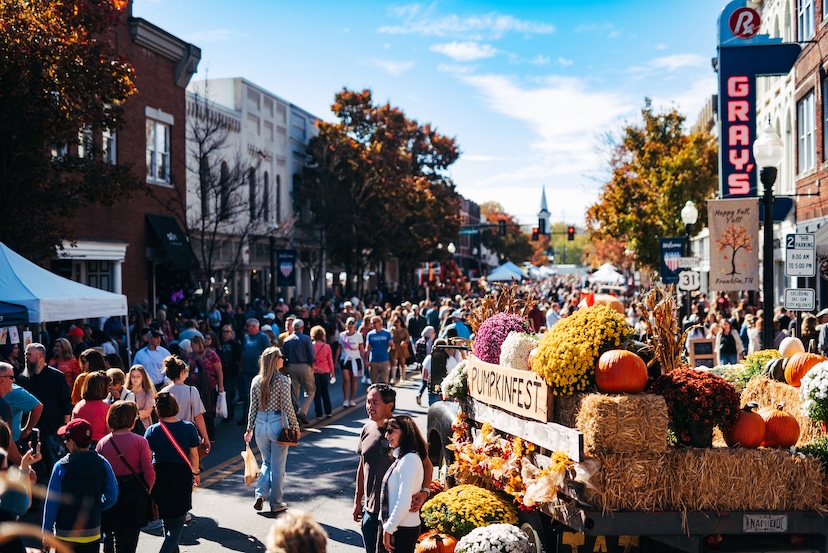
Crowds for PumpkinFest, one of Tennessee’s largest autumn festivals, fill Main Street in the historic section of Franklin. Downtown Franklin has been featured in Hallmark Channel movies. Photo courtesy of Visit Franklin
By Tom Adkinson
A farmer’s work never really ends, but there are a few breaks in the action, particularly when autumn harvest season winds down. The harvest season is a time of celebration – both literal and psychological – and today’s literal celebrations go way beyond the farmer and his or her family. Autumn means that it’s outdoor party time for all comers.
In the Mid-South where I live – a region without true geographic boundaries, but consider it to include Tennessee, Kentucky, Arkansas and parts of North Carolina, Virginia and West Virginia – we’ll celebrate almost anything that came out of the ground or once trod the earth. Scan festival calendars from these states, and you’ll find festivals dedicated to cornbread, hogs, apples, ducks (actually duck calling), watermelons, collard greens, potatoes, sunflowers and even woolly worms.
(You say you don’t know what a woolly worm is? More on them later, but for the moment, understand that the 13-band woolly worm’s track record for predicting winter weather may be better than your TV meteorologist’s.)
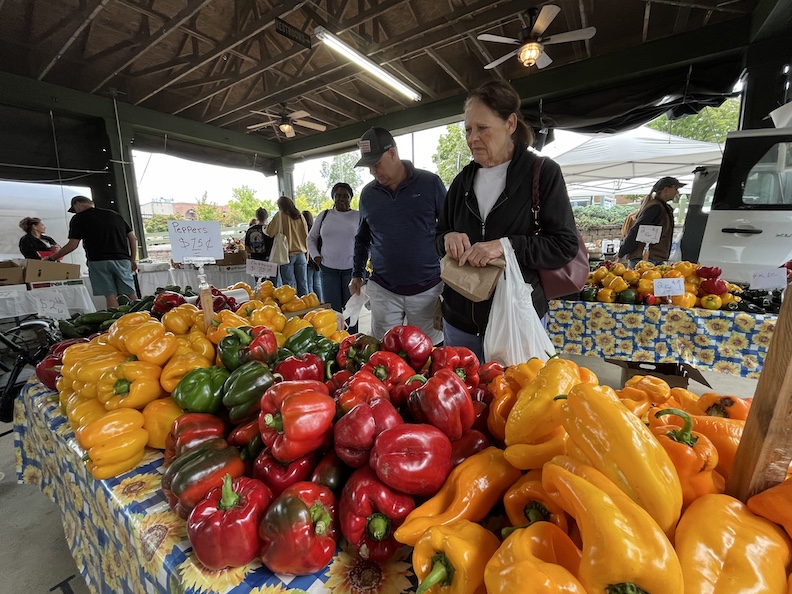
Gold, red and green bell peppers, rather than pumpkins, provide a splash of fall color at the weekly farmers market in Abingdon, Virginia. Shopping for fall produce is a major festival-season activity. Photo by Tom Adkinson
Variety is the (Pumpkin) Spice of Autumn Celebrations
Autumn is a peculiar time in the Mid-South. We might put on a sweatshirt when a cool morning dawns, but we’re still wearing short pants and sandals. Only well into fall do we concede that each day is a bit shorter. All the while, we hanker for college football, campfires and a party where we can yell (or even squeal) at a pig race, get turned around in a corn maze or laugh out loud as a giant air cannon blasts pumpkins into a Carolina-blue sky.
Fall festivals in this region range from well-organized and highly commercial to ones decidedly low-key and family-run activities. In Pigeon Forge, Tenn., Dollywood’s Harvest Festival is a full-blown theme park experience filling up September and October, while Shade Tree Farm and Orchard near tiny Adams, Tenn., casually offers apple cider, cider donuts, jams and hayrides on autumn weekends. Owners Tom and Sarah Head go all out on one Saturday in October and bring in food trucks and a bounce house.

A family prepares to challenge a 10-acre corn maze at Honeysuckle Hill Farm in Springfield, Tennessee. This maze’s design is a portrait of country music star Luke Bryan. Photo by Tom Adkinson
The region’s festivals are aimed not so much at farmers as they are at people who seek a little slice of farm or small-town life. The American Farm Bureau Federation says only about 2 percent of the U.S. population lives on farms or ranches, so the volume of farm-curious city folk is huge.
“Fall festivals show a sweetly remembered slice of society,” said Randall Dickerson, a retired Associated Press broadcast editor. “They take us back to the times our parents and grandparents talked about, recalling things we ourselves perhaps never experienced. Festivals give a certain appreciation of how things used to be – back when a majority of Americans did live on the farm.”
Harvest Festivals Reveal America Beyond the Big Cities
Nostalgia aside, Dickerson also notes that fall festivals show international visitors a broader picture of America, one that transcends the major cities and big-name attractions that probably were their first destinations.
PumpkinFest in Franklin, Tenn., 20 miles south of Nashville, is a major festival that puts the town’s 16-block historic district in the spotlight. One promoter describes the festival district as reminiscent of a Norman Rockwell painting or a Hallmark Channel movie set, which it has been.
Pumpkins aren’t a big crop around Franklin – in fact, Franklin imports a pumpkin weighing more than a thousand pounds from Ontario, Canada, every year – but regular-sized pumpkins, hay bales, scarecrows and pots of chrysanthemums set the mood for a festival that focuses on craftsmen and artisans.
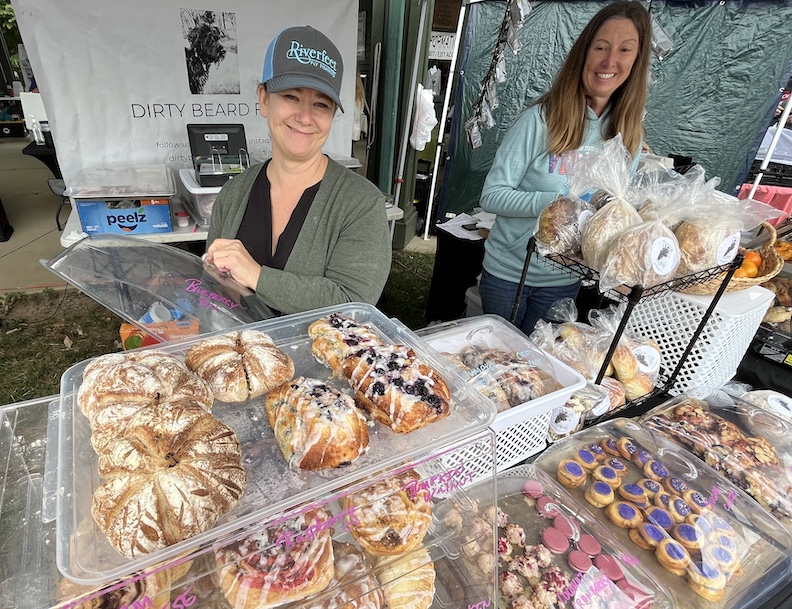
Pride from the bakers shows in the faces of these two vendors at the farmers market in Abingdon, Virginia. Fall festivals are famous for tasty treats. Photo by Tom Adkinson
“In a world where you can go to Amazon and receive whatever you want in 24 to 48 hours, it’s nice to see people who make things with their own hands. Yes, I can go to Target and buy a decorative bowl, but it’s an entirely different matter to meet a potter who throws clay, makes a bowl, fires it and glazes it himself,” says Noah Gray with the Heritage Foundation of Williamson County, the PumpkinFest organizer.
Racing Pigs and Flying Pumpkins
Homegrown pumpkins do play a big role at the Honeysuckle Hill Farm every fall. Justin Yates, a second-generation owner/operator of the 230-acre spread between Nashville and Clarksville, Tenn., devotes 30 acres to growing pumpkins, 90 percent of which he sells during a seven-week open house of sorts. He and his extended family use 65 acres for everything from an open-air building called a “corn box” that is 18 inches deep in shelled corn for kids to romp in, to an exhibit with billy goats, chickens and a turkey, to a mechanical band of life-size skeletons that sing show tune parodies.
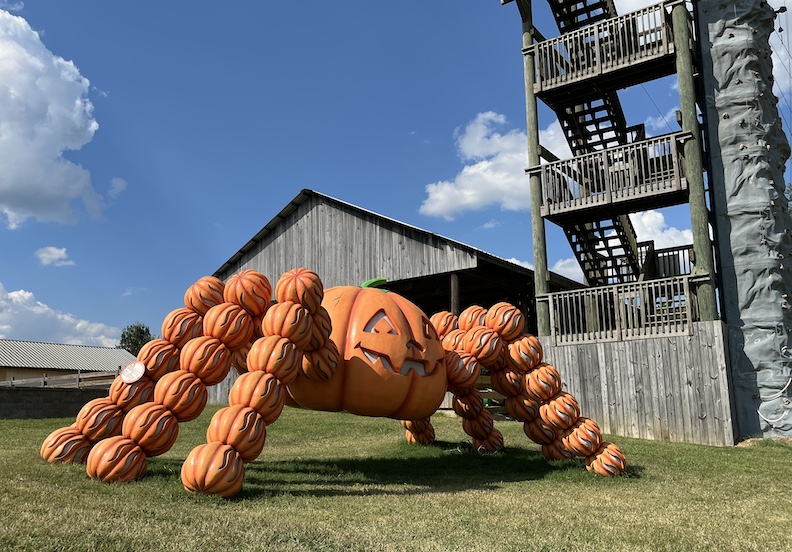
A jack-o-lantern morphs into a Halloween spider as a major prop at Honeysuckle Hill Farm in Springfield, Tennessee. The 230-acre farm operates a seven-week fall festival. Photo by Tom Adkinson
Yates grows 10 acres of corn that he cuts into a maze (designs are of famous country music singers such as Luke Bryan, Reba McEntire and George Strait), and then he harvests the corn after the autumn celebrations end. “There’s no reason for that corn to go to waste,” he declares.
Yates delights visitors by firing up a giant air cannon that rests atop a fire department’s ladder truck to launch pumpkins three-fourths of a mile over a line of trees and into a field. He also makes farm memories when he stages pig races around a small track he built with playground bleachers on one side.
The annual Trigg County Ham Festival in western Kentucky has pig races, too, but its initial focus is on what becomes of pigs when their racing days are through. A festival highlight is the multi-hour production that makes “Kentucky’s largest country ham biscuit.” It’s a real biscuit made with flour from Hopkinsville Milling Co. that’s at least 8 feet across. Bakers need a forklift to slide it into a special oven, and the finished biscuit gets cut into hundreds of individual servings that are stuffed with chunks of country ham.
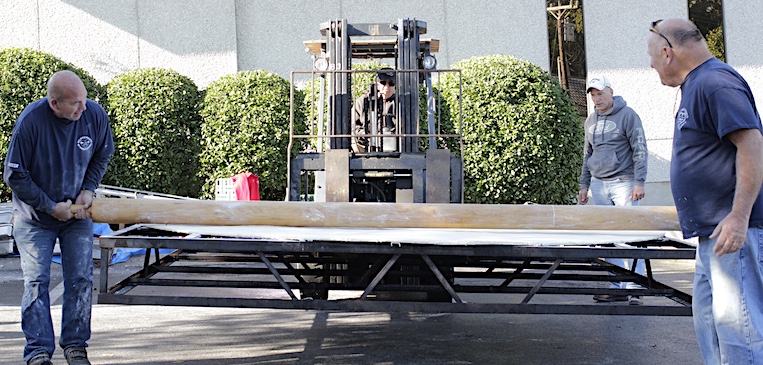
What may be the largest rolling pin you’ll ever see is needed to smooth out the dough for “Kentucky’s largest country ham biscuit” at the Trigg County Ham Festival. Photo courtesy of Trigg County Ham Festival
For the uninitiated, country ham is not like the sugar-cured ham on many Thanksgiving dinner tables. Country hams are salt- and air-cured and are an acquired taste. Drippings from frying a slice of country ham are needed for red-eye gravy, another treat for city folks to learn about.
Saddle Up Your Wooly Worm
Far across Kentucky on the Appalachian side of the state, tiny Beattyville (population 2,140) attracts thousands of people to the Daniel Boone National Forest for its three-day Woolly Worm Festival, proving that even a caterpillar can be a good excuse for a fall party. The festival includes a parade, a car show, a corn hole tournament, a pet show, live entertainment and perhaps most importantly, woolly worm races.
Festival chair Linda Smith, who also owns the local newspaper, says the festival began in 1987 when the community was looking for a fall activity. Various themes were bandied about until a local artist suggested they pay homage to the humble woolly worm, a predictor of winter.
“We are in very, very rural Kentucky, and there is folklore about how nature predicts the weather. How thick are the walnut hulls? How high in the trees are the hornet nests? What’s the pattern of brown and black bands of the woolly worm?” she explains.
Veteran attendees catch, feed and train their woolly worms – but the festival will provide you one if you come unprepared – according to Smith, who explains that the races are vertical events.
Pieces of string about four feet long are strung around the open-air edges of a three-sided structure. You place your worm below the starting point on a string and wait for the sound system to play “First Call,” just like at the Kentucky Derby. When the cry of “and they’re off!” goes out, the worms go up. From that point on, you can blow on your worm, holler at it, even pray for it. Just don’t touch it.
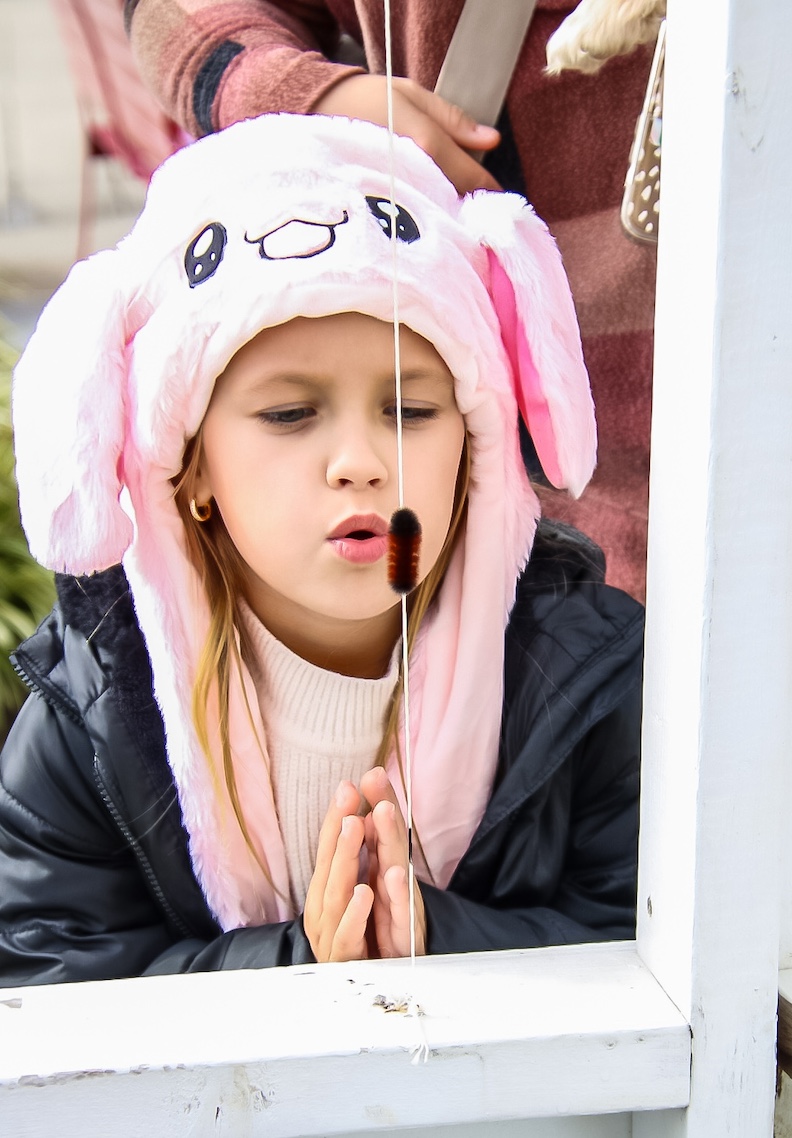
A youngster at the Woolly Worm Festival in Beattyville, Kentucky, encourages her weather-predicting caterpillar in a race to the top of a string. Nearby are 17 more racing caterpillars. Photo courtesy of Jessica Treadway/Just Jessica Photography
Winning worms compete in a final showdown. The champion earns $100 and a trophy for its owner and presumably the opportunity to morph into an Isabella tiger moth. Its pattern is the one that determines the winter weather forecast.
Capture Family Photos You’ll Never Get at Home
“Harvest festivals go way back – they’re even biblical. In today’s world, they offer teachable moments for city dwellers. They’re also cost-efficient family activities, and they are great photo opportunities for families far outside what’s normal for them,” says Paul Hart, a retired University of Tennessee agricultural extension agent.
Unusual photo ops, indeed. When else can you take photos of family members cheering for a racing pig, enjoying a hunk of a giant biscuit or blowing on a 13-band woolly worm?
How To Find a Fall Festival
Internet searches are the way to go. Start with the websites of state tourism departments, try “fall festivals near Pick Your City” or scour sites such as Funtober.com that gather festival basics from all over the country. Be sure to check for current information on any festival that interests you before jumping in the car.![]()
Tom Adkinson has lived in five southern states. His other EWNS stories include one about the man who taught Jack Daniel how to make whiskey and another about Charleston’s International African American Museum.

